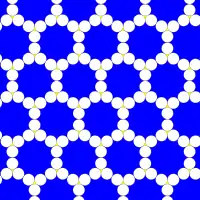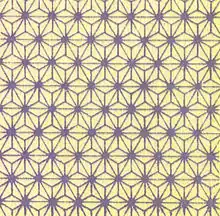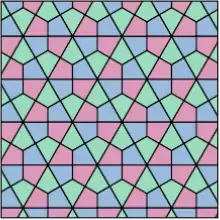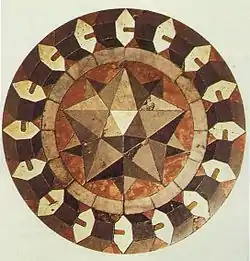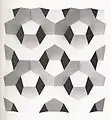Truncated hexagonal tiling
In geometry, the truncated hexagonal tiling is a semiregular tiling of the Euclidean plane. There are 2 dodecagons (12-sides) and one triangle on each vertex.
| Truncated hexagonal tiling | |
|---|---|
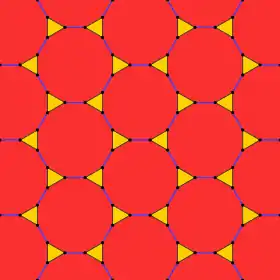 | |
| Type | Semiregular tiling |
| Vertex configuration |  3.12.12 |
| Schläfli symbol | t{6,3} |
| Wythoff symbol | 6 |
| Coxeter diagram | |
| Symmetry | p6m, [6,3], (*632) |
| Rotation symmetry | p6, [6,3]+, (632) |
| Bowers acronym | Toxat |
| Dual | Triakis triangular tiling |
| Properties | Vertex-transitive |
As the name implies this tiling is constructed by a truncation operation applies to a hexagonal tiling, leaving dodecagons in place of the original hexagons, and new triangles at the original vertex locations. It is given an extended Schläfli symbol of t{6,3}.
Conway calls it a truncated hextille, constructed as a truncation operation applied to a hexagonal tiling (hextille).
There are 3 regular and 8 semiregular tilings in the plane.
Uniform colorings
There is only one uniform coloring of a truncated hexagonal tiling. (Naming the colors by indices around a vertex: 122.)
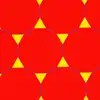
Topologically identical tilings
The dodecagonal faces can be distorted into different geometries, like:
 |
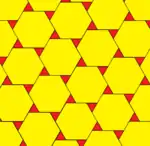 |
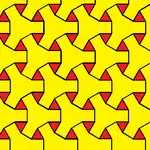 |
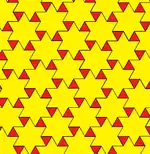 |
Related polyhedra and tilings
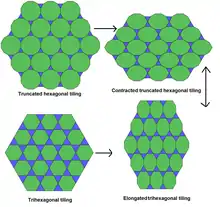
Wythoff constructions from hexagonal and triangular tilings
Like the uniform polyhedra there are eight uniform tilings that can be based from the regular hexagonal tiling (or the dual triangular tiling).
Drawing the tiles colored as red on the original faces, yellow at the original vertices, and blue along the original edges, there are 8 forms, 7 which are topologically distinct. (The truncated triangular tiling is topologically identical to the hexagonal tiling.)
| Uniform hexagonal/triangular tilings | ||||||||
|---|---|---|---|---|---|---|---|---|
| Fundamental domains |
Symmetry: [6,3], (*632) | [6,3]+, (632) | ||||||
| {6,3} | t{6,3} | r{6,3} | t{3,6} | {3,6} | rr{6,3} | tr{6,3} | sr{6,3} | |
 |
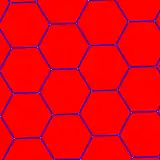 |
 |
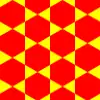 |
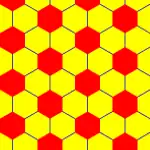 |
 |
 |
 |
 |
| Config. | 63 | 3.12.12 | (6.3)2 | 6.6.6 | 36 | 3.4.6.4 | 4.6.12 | 3.3.3.3.6 |
Symmetry mutations
This tiling is topologically related as a part of sequence of uniform truncated polyhedra with vertex configurations (3.2n.2n), and [n,3] Coxeter group symmetry.
| *n32 symmetry mutation of truncated tilings: t{n,3} | |||||||||||
|---|---|---|---|---|---|---|---|---|---|---|---|
| Symmetry *n32 [n,3] |
Spherical | Euclid. | Compact hyperb. | Paraco. | Noncompact hyperbolic | ||||||
| *232 [2,3] |
*332 [3,3] |
*432 [4,3] |
*532 [5,3] |
*632 [6,3] |
*732 [7,3] |
*832 [8,3]... |
*∞32 [∞,3] |
[12i,3] | [9i,3] | [6i,3] | |
| Truncated figures |
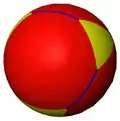 |
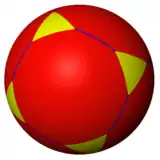 |
 |
 |
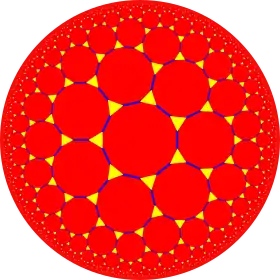 |
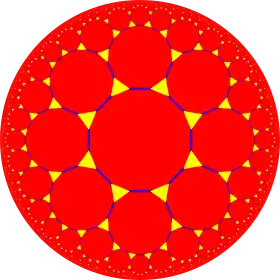 |
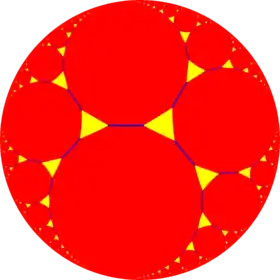 |
 |
 |
 | |
| Symbol | t{2,3} | t{3,3} | t{4,3} | t{5,3} | t{6,3} | t{7,3} | t{8,3} | t{∞,3} | t{12i,3} | t{9i,3} | t{6i,3} |
| Triakis figures |
 |
 |
 |
 |
 |
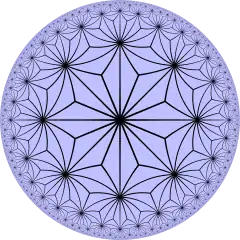 |
 |
||||
| Config. | V3.4.4 | V3.6.6 | V3.8.8 | V3.10.10 | V3.12.12 | V3.14.14 | V3.16.16 | V3.∞.∞ | |||
Related 2-uniform tilings
Two 2-uniform tilings are related by dissected the dodecagons into a central hexagonal and 6 surrounding triangles and squares.[1][2]
| 1-uniform | Dissection | 2-uniform dissections | |
|---|---|---|---|
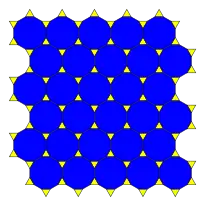 (3.122) |
  |
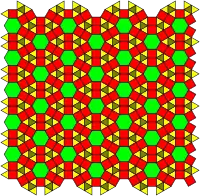 (3.4.6.4) & (33.42) |
 (3.4.6.4) & (32.4.3.4) |
| Dual Tilings | |||
 V3.122 |
.png.webp)
|
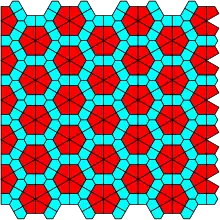 V3.4.6.4 & V33.42 |
 V3.4.6.4 & V32.4.3.4 |
Circle packing
The truncated hexagonal tiling can be used as a circle packing, placing equal diameter circles at the center of every point.[3] Every circle is in contact with 3 other circles in the packing (kissing number). This is the lowest density packing that can be created from a uniform tiling.
Triakis triangular tiling
| Triakis triangular tiling | |
|---|---|
 | |
| Type | Dual semiregular tiling |
| Faces | triangle |
| Coxeter diagram | |
| Symmetry group | p6m, [6,3], (*632) |
| Rotation group | p6, [6,3]+, (632) |
| Dual polyhedron | Truncated hexagonal tiling |
| Face configuration | V3.12.12 |
| Properties | face-transitive |
The triakis triangular tiling is a tiling of the Euclidean plane. It is an equilateral triangular tiling with each triangle divided into three obtuse triangles (angles 30-30-120) from the center point. It is labeled by face configuration V3.12.12 because each isosceles triangle face has two types of vertices: one with 3 triangles, and two with 12 triangles.
Conway calls it a kisdeltille,[4] constructed as a kis operation applied to a triangular tiling (deltille).
In Japan the pattern is called asanoha for hemp leaf, although the name also applies to other triakis shapes like the triakis icosahedron and triakis octahedron.[5]
It is the dual tessellation of the truncated hexagonal tiling which has one triangle and two dodecagons at each vertex.[6]
It is one of eight edge tessellations, tessellations generated by reflections across each edge of a prototile.[7]
See also
| Wikimedia Commons has media related to Uniform tiling 3-12-12 (truncated hexagonal tiling). |
- Tilings of regular polygons
- List of uniform tilings
References
- Chavey, D. (1989). "Tilings by Regular Polygons—II: A Catalog of Tilings". Computers & Mathematics with Applications. 17: 147–165. doi:10.1016/0898-1221(89)90156-9.
- "Archived copy". Archived from the original on 2006-09-09. Retrieved 2006-09-09.CS1 maint: archived copy as title (link)
- Order in Space: A design source book, Keith Critchlow, p.74-75, pattern G
- John H. Conway, Heidi Burgiel, Chaim Goodman-Strass, The Symmetries of Things 2008, ISBN 978-1-56881-220-5 "Archived copy". Archived from the original on 2010-09-19. Retrieved 2012-01-20.CS1 maint: archived copy as title (link) (Chapter 21, Naming Archimedean and Catalan polyhedra and tilings, p288 table)
- Inose, Mikio. "mikworks.com : Original Work : Asanoha". www.mikworks.com. Retrieved 20 April 2018.
- Weisstein, Eric W. "Dual tessellation". MathWorld.
- Kirby, Matthew; Umble, Ronald (2011), "Edge tessellations and stamp folding puzzles", Mathematics Magazine, 84 (4): 283–289, arXiv:0908.3257, doi:10.4169/math.mag.84.4.283, MR 2843659.
- John H. Conway, Heidi Burgiel, Chaim Goodman-Strass, The Symmetries of Things 2008, ISBN 978-1-56881-220-5
- Grünbaum, Branko & Shephard, G. C. (1987). Tilings and Patterns. New York: W. H. Freeman. ISBN 0-7167-1193-1. (Chapter 2.1: Regular and uniform tilings, p. 58-65)
- Williams, Robert (1979). The Geometrical Foundation of Natural Structure: A Source Book of Design. Dover Publications, Inc. p. 39. ISBN 0-486-23729-X.
- Keith Critchlow, Order in Space: A design source book, 1970, p. 69-61, Pattern E, Dual p. 77-76, pattern 1
- Dale Seymour and Jill Britton, Introduction to Tessellations, 1989, ISBN 978-0866514613, pp. 50–56, dual p. 117
External links
- Weisstein, Eric W. "Semiregular tessellation". MathWorld.
- Klitzing, Richard. "2D Euclidean tilings o3x6x - toxat - O7".

